|
JACOB/YA'AQOV - WRESTLING WITH HIMSELF |
Finally this jewel in the crown of my biblical interpretation has attracted a tune [2012]
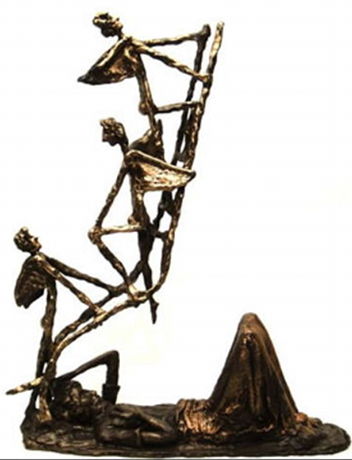 |
 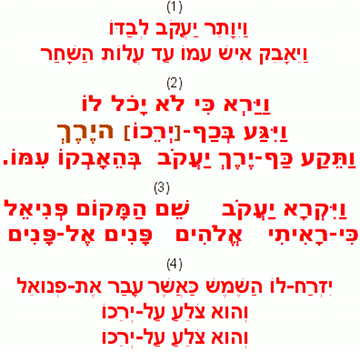
[adapted to the tune I heard at the end of a doc about the Paskha Islands] Phillip Ratner's sculptures I discovered on Oct. 21, 2013, see his earlier sculpture further down] |
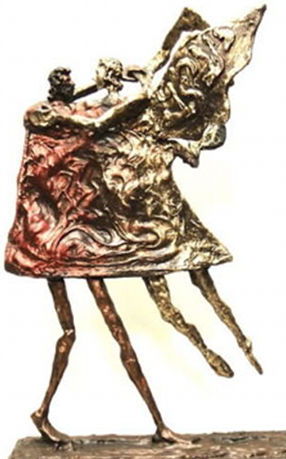 |
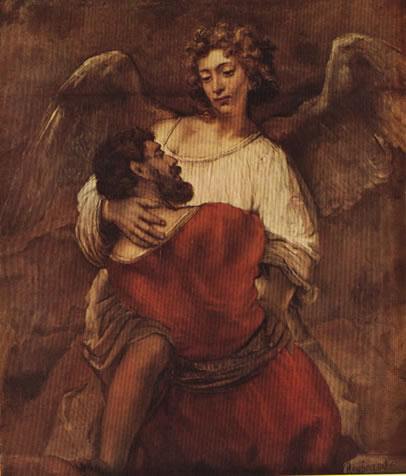

The inspiration I draw from Biblical stories,
helps me to cope with my life day by day.
But two of the most precious diamonds in a crown of jewels
are the complementary stories about the rivalry between two brothers:
The story of Kayin and Hevel, which ends with
murder and victimhood,
and the story of Ya'acov and Esau, which ends with peaceful separation.
The diamond of the latter radiates strongest, when the story reaches
Ya'aqov's so-called "Wrestling
with the Angel",
as interpreted by so many artists like these three:
Rembrandt, Delacroix and Chagall.
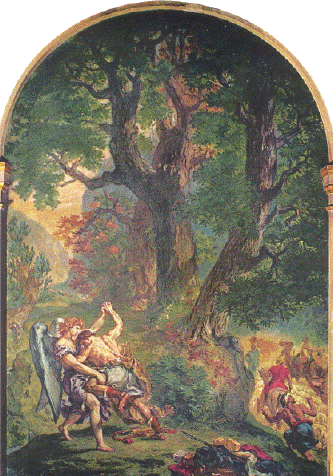 |
In
1986 I roamed through Paris
until I found the church of St. Sulpice.  I wanted to physically plunge into Eugene Delacroix's understanding of the wrestling. It was his last masterwork. So much could be said about how much the artists on this page differ in their perception of the two roles of the two wrestlers. But why should the language of my mind spoil the message of the paintings and sculptures? |
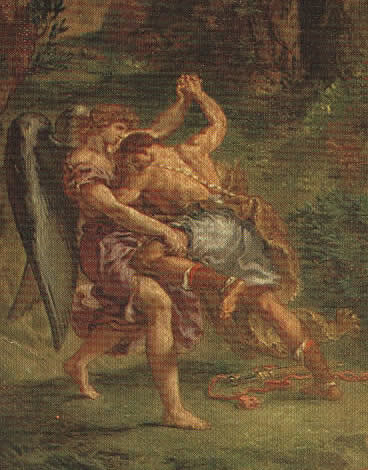 |
Gauguin's
sarcasm as I understand it, suits the part in me, which is bitter.
"How can millions and millions of Jews and
Christians hear and read this drama,
and - since they never saw an angel - disconnect their being from its message?!
And how can thousands of professional biblical interpreters miss the fact,
that the scene must not be severed from its context!
This mystical wrestling is tied into a physical-psychological reality:
the drama, of which Ya'acov is
the writer, the producer, the star
and to which he has cast a role for Esav and invited him as his main co-actor."
 |
From "All
the World's a Movie Set" |
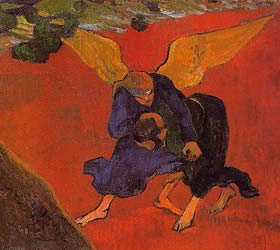 Gauguin 1988- Visitation after the sermon about Jacob wrestling with the Angel |
It's only in one of the prophetical books [Hosea
12:5],
that Ya'aqov's partner is transformed into an "angel",
i.e. a "messenger".
In the original story in Genesis
[32:25 ] it is just "a man"
['ish'],
by Buber-Rosenzweig rightly translated
as "einer",
i.e. "someone".
And as I understand the mystical scene in its Ya'aqov-Esav context:
the "someone" is Ya'aqov's own self,
[January 9, 2012 - as to the
wrestling with "my" Ya'acov,
see in"RedSeaPartnerSHIP"
and see "My Story with
Ya'acov"]
What helps me with Tomer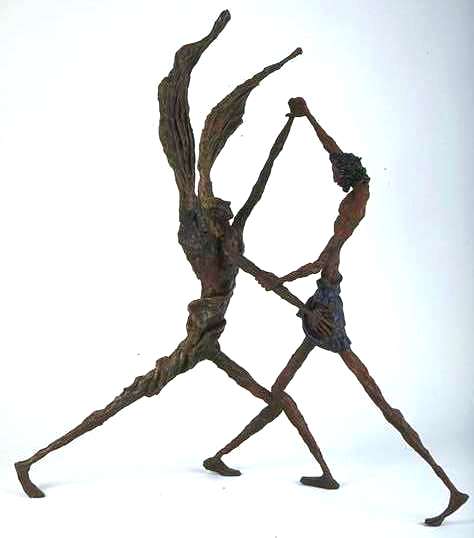 is Phillip
Ratner's sculpture
is Phillip
Ratner's sculpture
Names in the Bible are clues to personalities and vocations.
Following the wrestle, Ya'aqov's name is changed
into 'Israel'
"for you have fought with God and men and have prevailed".
Ya'aqov is the 'Heel-Sneak',
the bypasser, cheater, deceiver.
The story is a parable for what has to be learnt by us all..
Neither the biblical individual Ya'aqov,
nor the biblical and post-biblical people of Israel,
nor I myself
have yet learnt to wrestle/embrace,
instead of
succumbing or overriding, denying or fleeing.
|
I guided my grownup pupils through this outrageous
parable Since Ya'aqov is presented as the one who became
'Israel', |
From the introduction to the Ya'acov
cycle in the translation of
Everett Fox:
"But
he is the most dynamic and most human personality "Two
stories of sibling confrontation begin the Ya'acov cycle |
2005_08_12
Before I'll present the rest of the pages
-"Ya'aqov wrestling with himself"-
I want to quote, what I wrote in 1982:
From my lecture at
the Symposion of "Medicine and Bible" in Jerusalem in 1980
"But there is one situation of wholeness depicted in the Bible, which
implies,
that "being whole" means first of all -
to accept responsibility for whatever happens to me.
YA'AQOV/ISRAEL - "SHALEM"
"And Ya'acov came whole, shalem, to the city of Shechem"
(Gn
33:18)
This is a unique moment in the life of Ya'aqov.
Never again defines the Torah the state of mind of a person as "whole".
And it is a fleeting moment too,
for soon afterwards,
when the people of Shechem consent to the painful procedure of circumcision,
in order to become an integrated people with the strangers,
assuming, that "these men are w h o l
e with us, shlemim",
the assumption turns out to be a fatal illusion:
the wholeness of Ya'aqov and his sons was already
lost and gone (Gn
34:20)
Judged by the values of that time (and ours too),
Ya'aqov was a man,
whose character was even below the average weakness of human beings.
But it is his glimpse of wholeness,
which for a moment transformed him from Ya'aqov
into "Israel",
and it is the process of integration, which Ya'aqov
went through,
that might serve as a model for any human being.
Three times Ya'aqov had tried to
outwit his brother,
in order to shortcut the path to the blessing that was meant for him.
Three times he could have produced excuses for not being responsible for his
action:
the first time it happened,
while he was still unconscious in his mother's womb (Gn
25:26),
the second time it was a proper deal,
accomplished with the conscious collaboration of his brother (25:
3-34).
The third time it was his mother, who manouvered him into the deceit (27:6-36).
But the excuses have no bearing on the consequences that Ya'aqov
has to bear:
twenty years of exile, of slavery
and of being cheated
the very same way that he had cheated his brother
(Gn 29,25f;
31:6f: 38ff)
and twice the necessity to flee,
which is "brekhah", flight,
and not 'brakhah", blessing
(Gn
27:34;Gn 35:1.7
and Gn 31:20.21.22.27)
These twenty years taught him, that there was no short-cut
to his blessing.
But even when he was mature enough to return home,
the obstacle, which he himself had put in his own way,
was still ahead:
he was still dependent on his enemy in order to enjoy his blessing.
Since the alternatives of fight or flight are out of the question
(the balance of power is to the disadvantage of Ya'aqov
and the contract with Lavan allows no going back to Haran),
he has no choice but coping with the enmity in his brother's heart.
Sure, before he becomes fully aware of this situation,
he makes three attempts of finding an easy way out:
1) Naively announcing his return without relating to the past;
2) focusing on rescuing at least part of his family,
thus in fact surrendering to defeat in advance;
3) trying to manipulate his god to do the job for him (Gn
32:3-12).
but the attempts don't work!
He was engulfed by darkness (Gn
32: 13.21.22) and all alone (24),
when he finally accepted responsibility
for coping with the present consequences of his past shortcuts,
-for "wrestling" instead of cheating and fleeing.
On the exterior scene he invents a maneuver which is highly
sophisticated psychologically,
but he also sincerely acknowledges,
that he is in dire need of his brother's forgiveness (14-20).
By both means, the tactics and the confession,
he transforms his enemy's feelings (Gn
33:4).
What is even more surprising is the interior scene,
which clearly depicts the process of integration of past and present,
which takes place in Ya'aqov's heart,
and through this integration Ya'aqov's own transformation:
a man "wrestles"
(the unique use of this root: "avq" is
an exchange of the sounds in the root "aqv",
underlying Ya'aqov's name; cp. Buber)
with Ya'aqov at night,
but soon roles are exchanged
and it is Ya'aqov who wrestles with the man.
By dawn the defeated man assures him
that now "Ya'aqov, Heel-Sneak", has become
"Yisrael, Fighter of God"
((Gn
32:28, translation: Fox).
When he receives the blessing, he has yearned for so long,
he realizes that he has faced "the face of God"
(Gn
32:30)
or as he interprets it on the exterior scene:
"I've seen your, Esav's, face as if seeing the face
of God!" (Gn
33:10).
C.G. Jung would say, that he faced "Self"
overcoming the conflict between Ego and Self, and thus becoming whole.
By externalizing the interiour process,
Ya'aqov urges Esav to take from his material blessing,
for only by giving back the blessing he has stolen he can really receive his blessing Gn 33:11)
